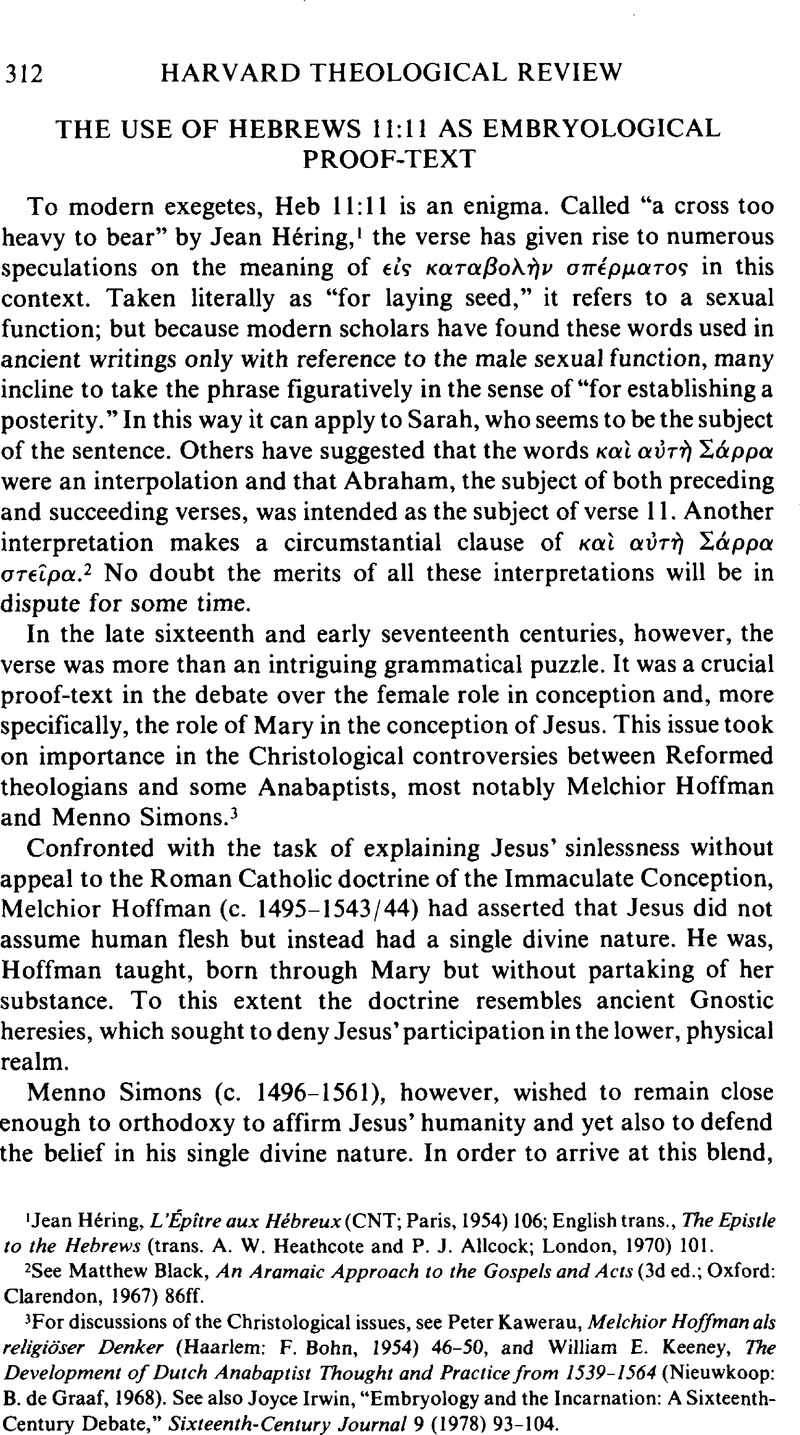Article contents
The Use of Hebrews 11:11 as Embryological Proof-Text
Published online by Cambridge University Press: 10 June 2011
Abstract

- Type
- Notes and Observations
- Information
- Copyright
- Copyright © President and Fellows of Harvard College 1978
References
1 Héring, Jean, L'Épître aux Hébreux (CNT; Paris, 1954) 106Google Scholar; English trans., The Epistle to the Hebrews (trans. Heathcote, A. W. and Allcock, P. J.; London, 1970) 101Google Scholar.
2 See Black, Matthew, An Aramaic Approach to the Gospels and Acts (3d ed.; Oxford: Clarendon, 1967) 86ffGoogle Scholar.
3 For discussions of the Christological issues, see Kawerau, Peter, Melchior Hoffman als religiöser Denker (Haarlem: F. Bohn, 1954) 46–50Google Scholar, and Keeney, William E., The Development of Dutch Anabaptist Thought and Practice from 1539–1564 (Nieuwkoop: B. de Graaf, 1968)Google Scholar. See also Irwin, Joyce, “Embryology and the Incarnation: A Sixteenth-Century Debate,” Sixteenth-Century Journal 9 (1978) 93–104Google Scholar.
4 Concerning the word “to conceive,” the Oxford English Dictionary (II. 757) notes that in Latin “the primary notion was apparently ‘to take effectively, take to oneself, take in and hold.'”
5 Desiderius Erasmus, In Novum Testamentum … Annotationes (Basel, 1516) 582.
6 See Hauck, Albert, Realencyklopädie für protestantische Theologie und Kirche (Leipzig, 1903), XIII. 56–57Google Scholar; Gerretsen, J. H., Micronius, Zijn leven, zijn geschriften, zijn geestesrichting (Nijmegen, 1895)Google Scholar.
7 Simons, Menno, “Reply to Martin Micron,” The Complete Writings of Menno Simons (trans. Verduin, Leonard; Scottdale, PA: Herald, 1956) 849Google Scholar.
8 Theodore Beza's Latin New Testament of 1556, while giving Sarah a more active role from a grammatical perspective, did not significantly change the sense of the verse: “Per fidem Sara, quae sterilis erat, accepit vim ut conciperet semen. “The Geneva Bible of 1560 does not reveal any new understanding: “Through faith Sarra also received strength to conceyve sede.” And a French translation published in Lyon in 1561, reminiscent of Erasmus, emphasized Sarah's receptive potential: “Par foy Sara aussi receut force pour concevoir et retenir semence.”
9 Guy de Bres, La Racine, Source et Fondement des Anabaptistes ou Rebaptisez de Nostre Temps (n.p., 1565) 200.
10 Ibid.
11 Biblia, Dat is: De gantsche H. Schrifture (Leyden, 1637).
12 The Dutch Annotations upon the whole Bible (London, 1657).
13 Ibid. Spelling modernized.
14 Daniel Heinsius, Sacrarum Exercitationum ad Novum Testamentum Libri XX (2A ed.; Cambridge, 1640) 541–42.
15 Cf. John Chrysostom, “Homily XXIII on Hebrews”: “By faith also Sarah received strength to conceive seed even when she was past age. What is, ‘to conceive seed”? She who was become dead, who was barren, received power for the retaining of seed, for conception. For the imperfection was two-fold; first from her time of life, for she was really old; secondly from nature, for she was barren.” (Nicene and Post-Nicene Fathers [ed. Schaff, Philip; New York, 1890], XIV. 471Google Scholar.)
16 Cremoninus, Caesar, De calido innato, el semine, pro Aristotele adversus Galenum (Leiden, 1634Google Scholar; earlier ed., Venice, 1626).
17 Beverwyck, Johann van, Van de Wtnementheyt des Vrouwelichen Geslachts (Dordrecht, 1639)Google Scholar. See also my article, “Anna Maria van Schurman: From Feminism to Pietism,” Church History 46 (1977) 48–62Google Scholar.
18 Hermann Faukelius (ca. 1560–1625), a Dutch reformed minister, published a new Dutch translation of the New Testament in 1617 and was one of the translators of the “state translation” of the Bible.
19 Beverwyck, p. 16.
- 1
- Cited by




